There’s nothing more heartbreaking than a pan of homemade Alfredo that goes wrong. You know the moment. In one second, you have a beautiful, simmering cream sauce. The next, it’s a separated, grainy mess. I’ve been there, and after 30 years of making every pasta dish imaginable, I refuse to let it happen in my kitchen—or yours.
Forget everything you’ve been told about just melting cheese into cream. That’s a recipe for disaster. The real secret—the one that restaurants know—is building a simple, stable flavor base. We’re going to use a classic French technique to create a sauce so luxurious and flawlessly smooth, it’s practically guaranteed to work. This isn’t just a recipe; it’s the definitive method for a perfect chicken alfredo from scratch, where tender, juicy chicken is coated in a sauce that absolutely refuses to fail.
Why This Recipe Is the Only One You’ll Ever Need
- The Unbreakable Silky Sauce: My method of building a simple, 2-minute flavor base first makes a grainy or separated sauce virtually impossible. It’s the ultimate insurance policy for creamy results.
- Truly Restaurant-Quality Flavor: We’re not just melting ingredients; we’re building layers of deep, savory flavor that you can’t get from simpler recipes. This tastes like it came from a high-end Italian kitchen.
- Actually Freezer-Friendly: Unlike other recipes that warn against freezing, I’ll show you how to make this entire dish ahead of time so you can have a gourmet-level dinner ready whenever you are.
- Proactively Solves Problems: This guide doesn’t just give you steps; it gives you the why behind them, turning you into a more confident cook and troubleshooting any issue before it even starts.
The Building Blocks of a Perfect Alfredo
Great cooking starts with great ingredients. For a dish as classic as Chicken Alfredo, we’re not relying on a long list of fancy items. Instead, we’re using a handful of high-quality staples that work together perfectly. There are no distractions here—no cream cheese, no garlic powder, no out-of-place lemon juice—just pure, rich, authentic flavor.
Key Ingredients
- For the Chicken & Pasta:
- Chicken Breast: Boneless, skinless chicken breast, pounded to an even thickness for perfect cooking.
- Fettuccine: The classic choice. Its wide, flat shape is the perfect vehicle for clinging to our luxurious sauce.
- Olive Oil & Butter: For pan-searing the chicken to a beautiful golden brown.
- Salt & Black Pepper: To season the chicken and the final sauce.
- For the Foolproof Alfredo Sauce:
- Unsalted Butter: The foundation of our sauce’s flavor.
- All-Purpose Flour: This is the secret to our “unbreakable” sauce, creating a light roux that prevents any graininess.
- Garlic: Finely minced for an aromatic flavor base.
- Whole Milk & Heavy Cream: This combination provides the perfect balance of richness and a silky consistency without being too heavy.
- Parmesan Cheese: The soul of the sauce. Please, please use a block of real Parmigiano-Reggiano.
- Nutmeg: Just a tiny pinch. It’s a classic trick that enhances the creamy flavors without tasting like a spice cookie. You won’t know it’s there, but you’ll miss it if it’s gone.
⭐ The Two “Star” Ingredients You Can’t Compromise On
- A Block of Real Parmesan Cheese: This is non-negotiable for a smooth, flavorful sauce. The pre-shredded stuff in bags or the powder in a green can is coated with anti-caking agents like cellulose (wood pulp!). These additives prevent the cheese from melting properly and are the #1 cause of a grainy, clumpy Alfredo. Grating your own from a block of good Parmigiano-Reggiano takes 30 seconds and guarantees a velvety melt and a deep, nutty flavor you just can’t get from a bag.
- Full-Fat Dairy (Heavy Cream & Whole Milk): Fat is flavor, but it’s also your best friend for creating a stable cream sauce. The high-fat content in heavy cream and whole milk allows them to heat without curdling or breaking, which is a common problem with lower-fat dairy like 2% or skim milk. This duo creates a sauce that is both unbelievably creamy and just the right consistency to coat the pasta beautifully.
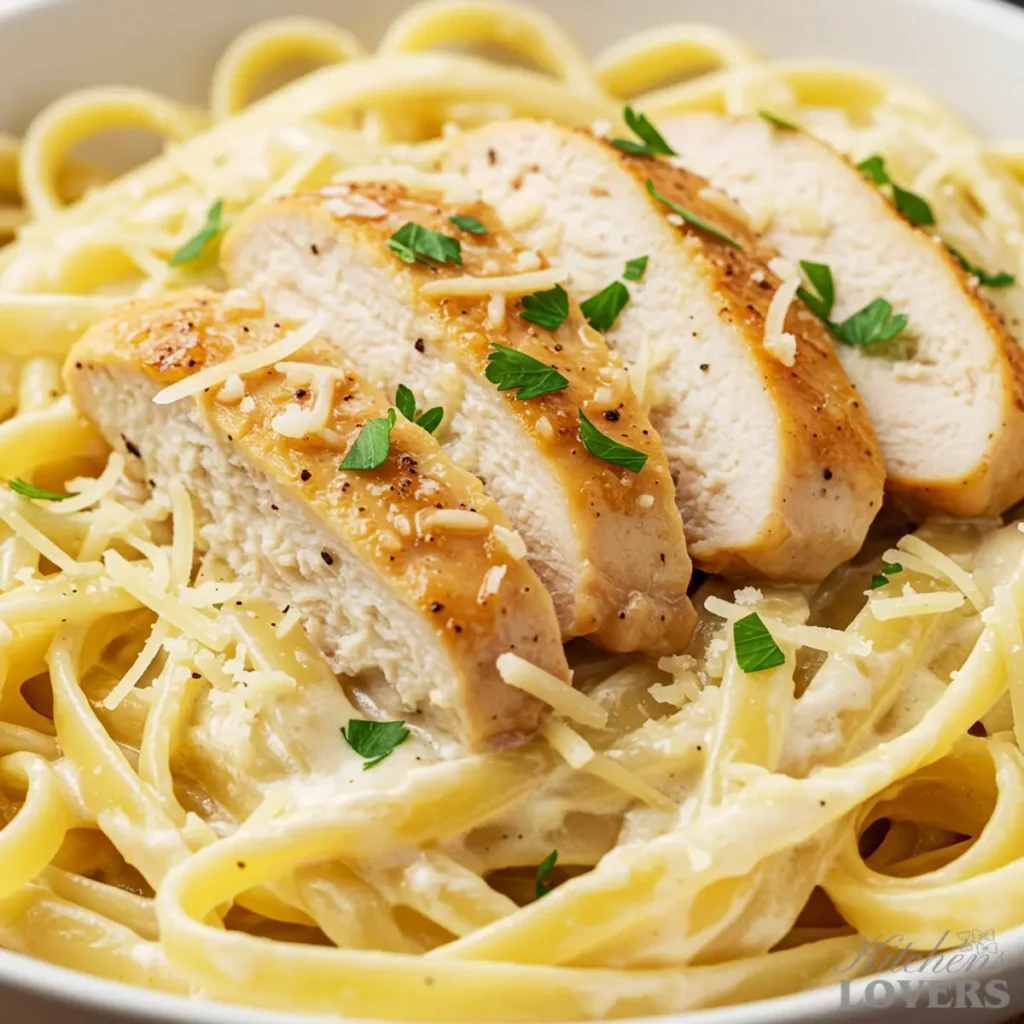
Smart Swaps & Substitutions
| Ingredient | Best Substitution | Notes |
| Chicken Breast | Boneless, skinless chicken thighs | Thighs will add even more rich flavor but may need a few extra minutes to cook through. |
| Fettuccine | Linguine, Pappardelle, or Penne | Any sturdy pasta will work, but long cuts are traditional and best for sauce-clinging. |
| Parmesan | Pecorino Romano | Pecorino is a great alternative but it is saltier and has a sharper flavor. Reduce any other salt you add. |
| All-Purpose Flour | 1:1 Gluten-Free Flour Blend | For a gluten-free version, a good quality GF blend works perfectly in the roux. |
The Essential Equipment for Sauce Success
You don’t need a kitchen full of professional gadgets. Success comes down to using a few well-chosen tools and, just as importantly, having them ready before you start. This is how restaurant chefs guarantee consistency, and it’s how we’ll guarantee a flawless Alfredo. Here’s what truly matters.
- A Large, Heavy-Bottomed Pan (Your #1 Ally): If there is one piece of equipment that makes or breaks this dish, it’s this. I recommend a 12-inch cast-iron skillet, a heavy stainless-steel sauté pan, or a Dutch oven. Why it’s critical: Thin, cheap pans have hot spots that will scorch your garlic and, even worse, cause the dairy in your sauce to break and turn grainy. A heavy bottom distributes the heat slowly and evenly, which is your number one defense against a broken sauce. Think of it as your insurance policy for that silky, creamy texture we’re after.
- A Sturdy Whisk: This is absolutely vital for building our smooth, lump-free flavor base (the roux). A fork or a spoon won’t cut it—a whisk is designed to incorporate the flour and liquids together perfectly.
- A Large Pot for Pasta: Give your fettuccine plenty of room to boil. This prevents it from sticking together and ensures it cooks evenly. Don’t forget to salt your pasta water generously! It’s your first and best chance to season the pasta itself.
- A Box Grater or Microplane: Since we’re using a real block of Parmesan, you’ll need to grate it yourself. A microplane is my preferred tool, as it creates feathery, superfine shreds that melt into the sauce almost instantly, which is another trick to prevent clumping. A standard box grater works great, too.
Your Foolproof Alfredo Guide (Expert Tips & Troubleshooting)
Over the years, my test kitchen has seen it all. The broken sauces, the bland flavors, the clumpy messes. That experience is baked right into this recipe, designed to proactively solve every common Alfredo problem before it can even start. These are the “insider” secrets that make all the difference.
Recipe Rescue: How to Instantly Fix a Grainy or Broken Sauce
First, take a deep breath. Do not throw that sauce away! If you look in the pan and see a gritty, separated, or oily mess, we can absolutely fix it. This almost always happens for one reason: the heat was too high when the cheese was added, causing the dairy proteins to curdle and the fat to separate.
Here is your emergency rescue plan:
- Kill the Heat. Immediately remove the saucepan from the hot burner. Stop the cooking process dead in its tracks.
- Add a Splash of Cold Cream. Pour just a tablespoon of cold heavy cream or milk into the sauce. Start small; we don’t want to thin out the sauce. You can always add a second tablespoon if needed, but one is usually enough to start the rescue. Do NOT add hot liquid. The sudden drop in temperature is what helps the magic happen.
- Whisk Like You Mean It. Grab your whisk and, starting in the very center of the pan, begin whisking vigorously in small, tight circles. As the center starts to become smooth and creamy again, gradually widen your circles to incorporate the rest of the broken sauce. Within about 30 seconds of aggressive whisking, you should see the emulsion come back together into a smooth, silky state.
The Golden Rule: Always Grate Your Own Cheese
I mentioned this in the ingredients, but it’s the single most important tip I can give you. If you learn nothing else, learn this: Never, ever use pre-shredded, bagged Parmesan. Those cheese shreds are coated in starches and cellulose to prevent them from sticking together in the bag. When you dump them into a hot sauce, that coating prevents the cheese from melting and instead creates a gritty, clumpy texture. It is the #1 saboteur of homemade Alfredo. Grating your own from a block takes seconds, and it’s the only way to guarantee your cheese will melt flawlessly into a velvety sauce.
The Secret to a Perfectly Smooth Roux (And Why We Use One)
Why doesn’t our sauce break in the first place? Because we build a simple, two-minute foundation called a roux. It sounds fancy, but it’s just a cooked paste of butter and flour that works as a stabilizer. It gives the cream and milk something to hold onto, making the final sauce incredibly stable and rich.
Here’s how to do it perfectly: Melt the butter over medium heat. Now, sprinkle the flour evenly over the top and start whisking immediately. For the next 60 to 90 seconds, your only job is to keep that whisk moving. You’re not trying to brown it; you’re just cooking out the raw, pasty flavor of the flour. You’ll know it’s ready when the mixture looks like wet sand and your kitchen starts to fill with a nutty, toasty aroma. This simple step is your insurance policy for a flawless sauce. Get this right, and you’ll likely never need the ‘Recipe Rescue’ plan in the first place.
Step-by-Step Instructions for Chicken Alfredo from Scratch
Follow these steps closely, and I promise you’ll feel like a restaurant chef in your own kitchen. We’ll build this dish in stages: first the pasta and chicken, then our glorious, unbreakable sauce.
Time Needed: 45 minutes.
1.Prep and Cook the Pasta
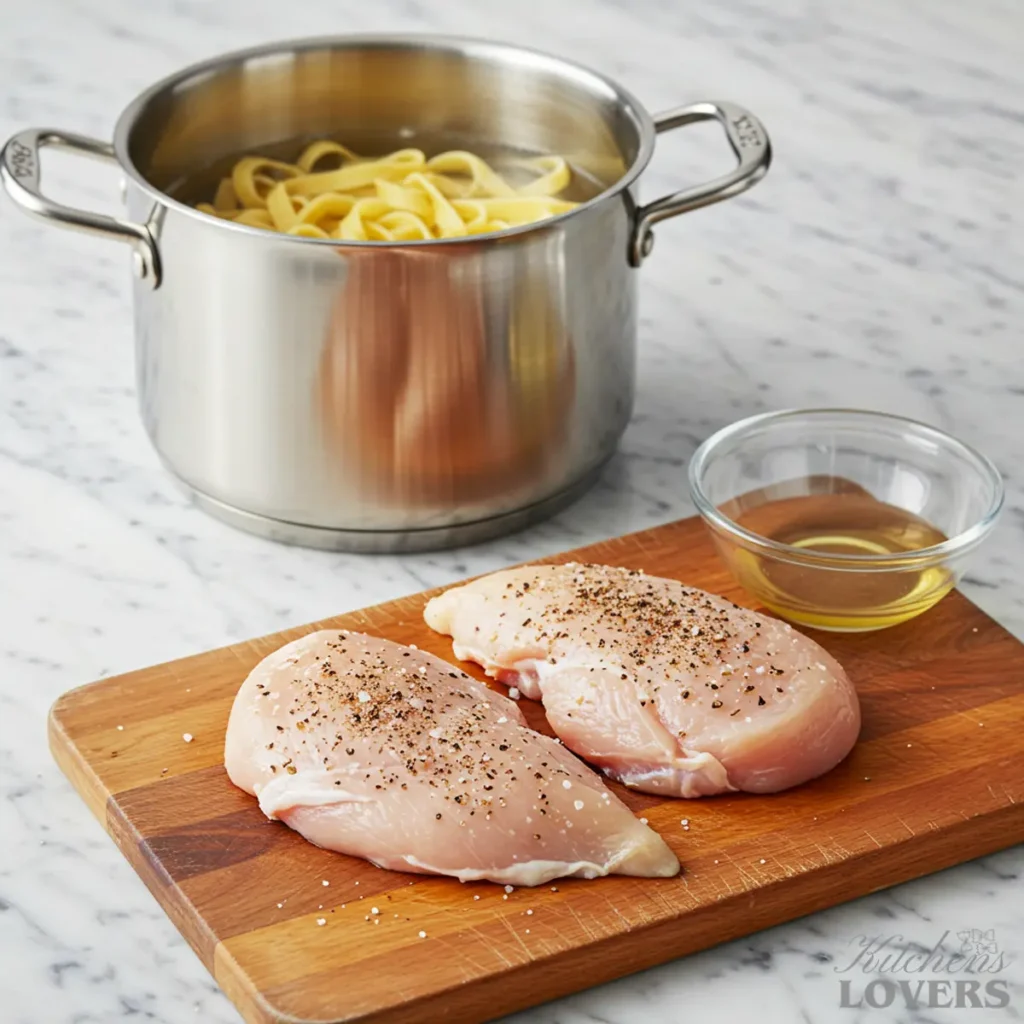
- Start the Pasta Water: Get a large pot of water on the boil. Once it’s at a rolling boil, add a generous amount of salt (it should taste like the sea). This is your only chance to season the pasta itself.
- Prep the Chicken: While the water heats up, prepare your chicken. If your chicken breasts are thick, slice them in half horizontally or pound them to an even ½-inch thickness. This is key for fast, even cooking. Pat them completely dry with a paper towel and season both sides generously with salt and pepper.
- Cook the Fettuccine: Add the fettuccine to your boiling water and cook according to the package directions, usually about 8-10 minutes. We want it al dente—cooked through but still with a firm bite. Just before you drain it, be sure to reserve about one cup of the starchy pasta water. This liquid gold is perfect for thinning the sauce later if needed.
2.Sear the Chicken
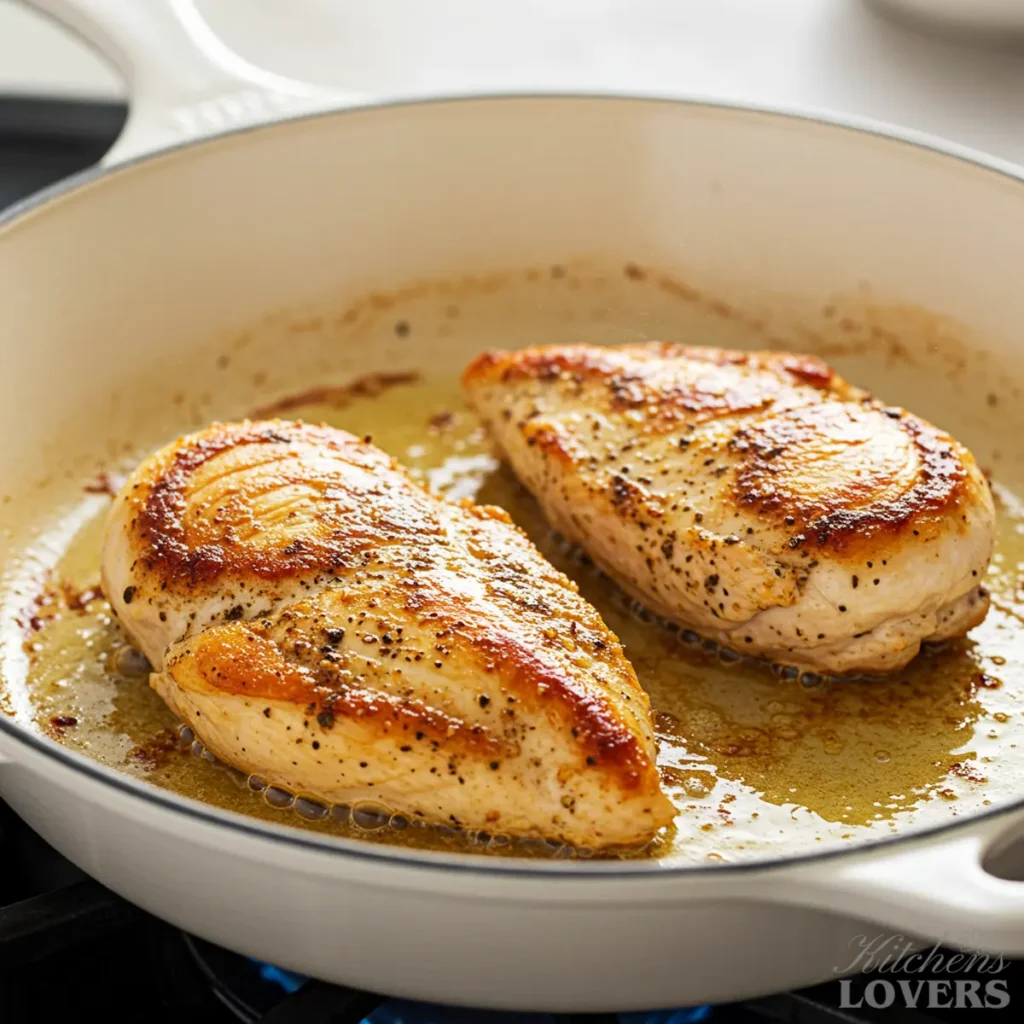
- Heat the Pan: Place your large, heavy-bottomed skillet over medium-high heat. Add a tablespoon of both butter and olive oil. Once the butter is melted and foaming, you’re ready.
- Sear to Perfection: Carefully lay the seasoned chicken breasts in the hot pan, leaving space between them. Let them cook, undisturbed, for about 4-6 minutes per side. You’re looking for a deep, golden-brown crust. The exact time will depend on the thickness.
- Rest the Chicken: After resting, slice it into thin strips. If you find the chicken is still a little pink in the middle, don’t worry! It will finish cooking through perfectly in the hot sauce in the final step. Don’t you dare wipe out that pan! This is critical—it allows the juices to redistribute, ensuring every bite is tender and moist. After resting, slice it into thin strips. Don’t you dare wipe out that pan! Those browned bits on the bottom are pure flavor.
3.Make the Foolproof Alfredo Sauce
Now for the main event. Ensure you reduce the heat to a steady medium now. This is crucial. We’ll build our sauce right in the same pan, using all that flavor from the chicken.
First, make the roux.
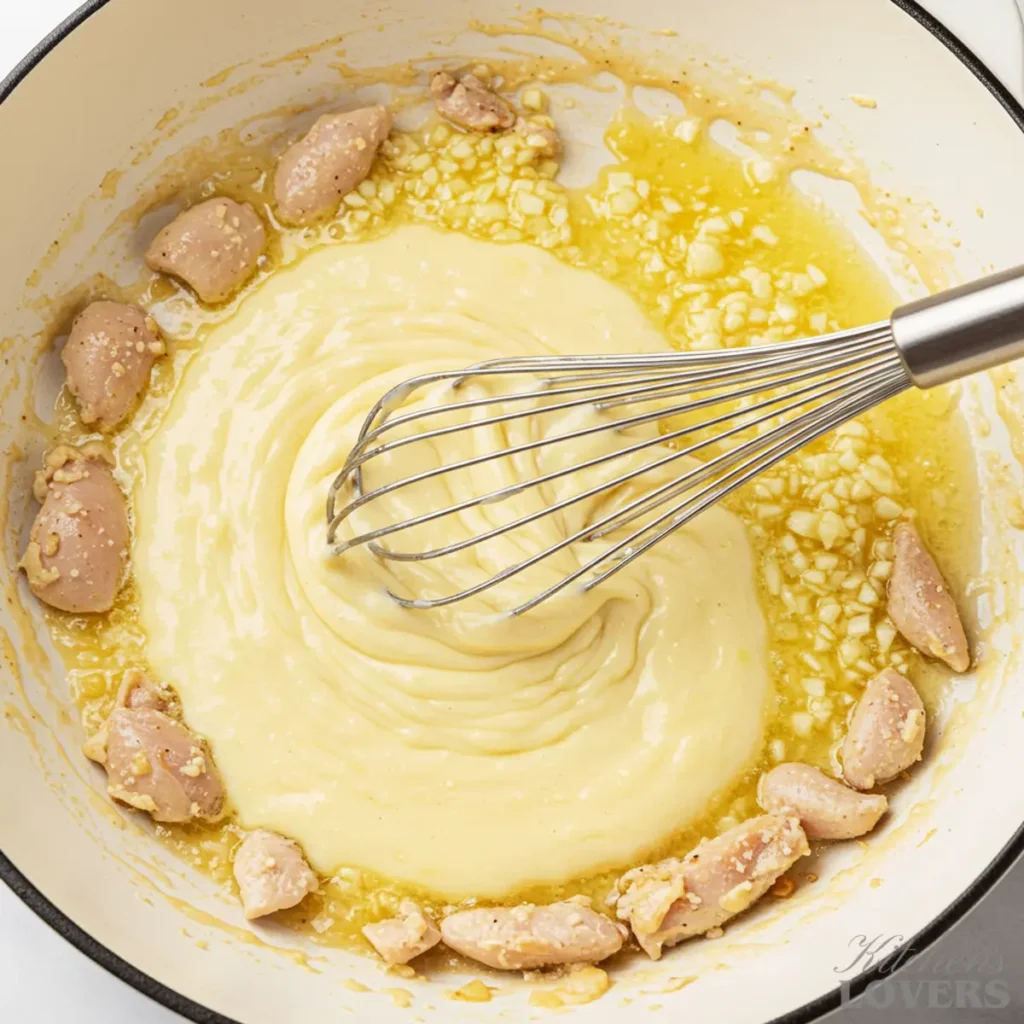
- Melt Butter & Sauté Garlic: Reduce the heat to medium. Add the remaining 4 tablespoons of butter to the skillet. Once it’s melted, add your minced garlic and cook for just 30-60 seconds, stirring constantly. You just want it to become fragrant—that nutty, irresistible aroma that perfumes your entire kitchen. Don’t let it brown!
- Cook the Flour: Sprinkle the all-purpose flour over the melted butter and garlic. Immediately begin to whisk. Keep whisking for about 90 seconds. You’re cooking out the raw flour taste and creating a light, sandy-colored paste. This is the simple “flavor base” that guarantees your sauce won’t break.
Next, build the cream sauce.
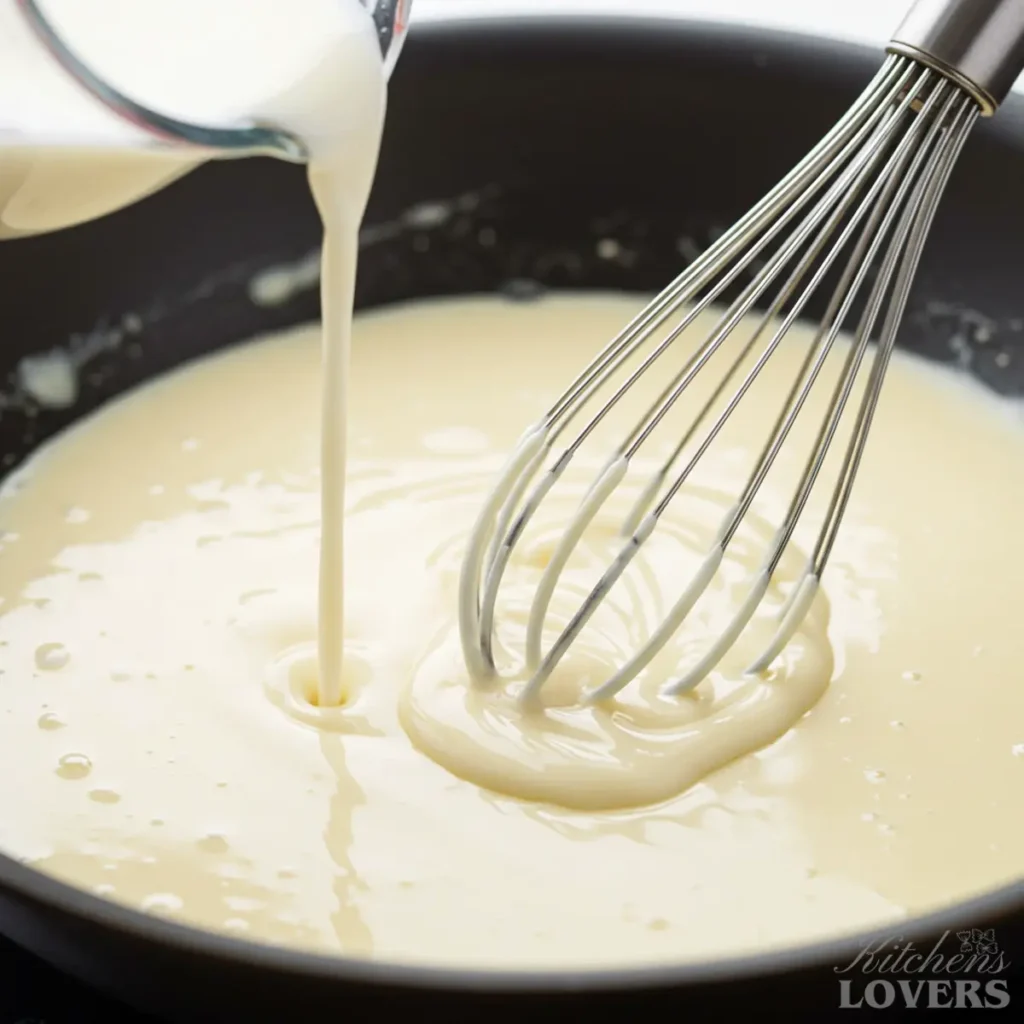
- Whisk in the Milk: Now, while whisking constantly, start slowly pouring in the whole milk. Add just a little bit at first, whisking until it’s smooth before adding more. This will prevent any lumps.
- Add the Cream: Once all the milk is incorporated and the sauce is smooth, pour in the heavy cream and the pinch of nutmeg. Keep whisking as you bring the sauce to a gentle simmer. Let it bubble gently for about 2-3 minutes to thicken. The sauce should be thick enough to coat the back of a spoon.
Finally, Melt the Cheese
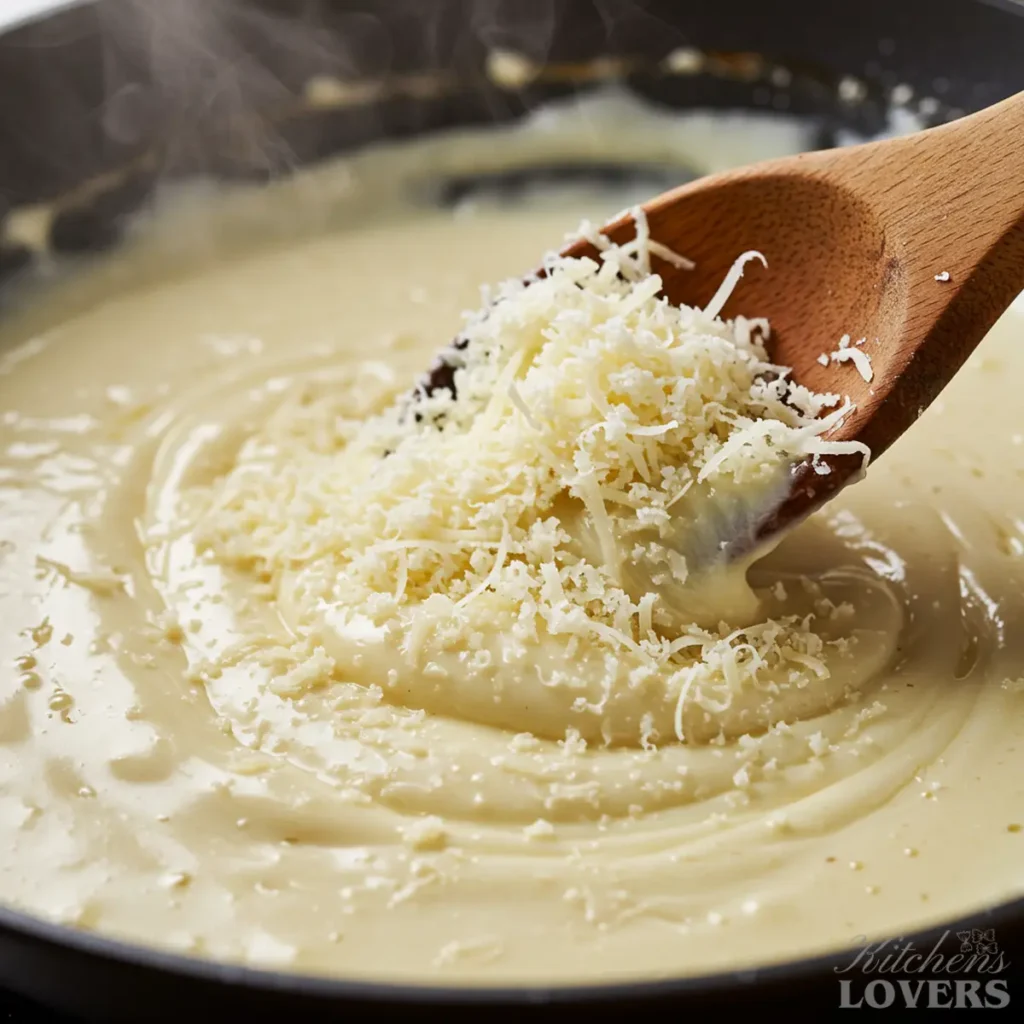
- Turn Down the Heat: This is the most important part. Turn the heat down to low. A blistering hot sauce will make your cheese curdle and get grainy, and we’ve worked too hard for that.
- Stir in the Parmesan: Add your freshly grated Parmesan cheese, a handful at a time, stirring gently and constantly with your whisk or a wooden spoon until each addition is fully melted and the sauce is velvety smooth. Taste the sauce now and add more salt and black pepper if needed.
Step 4: Bring It All Together
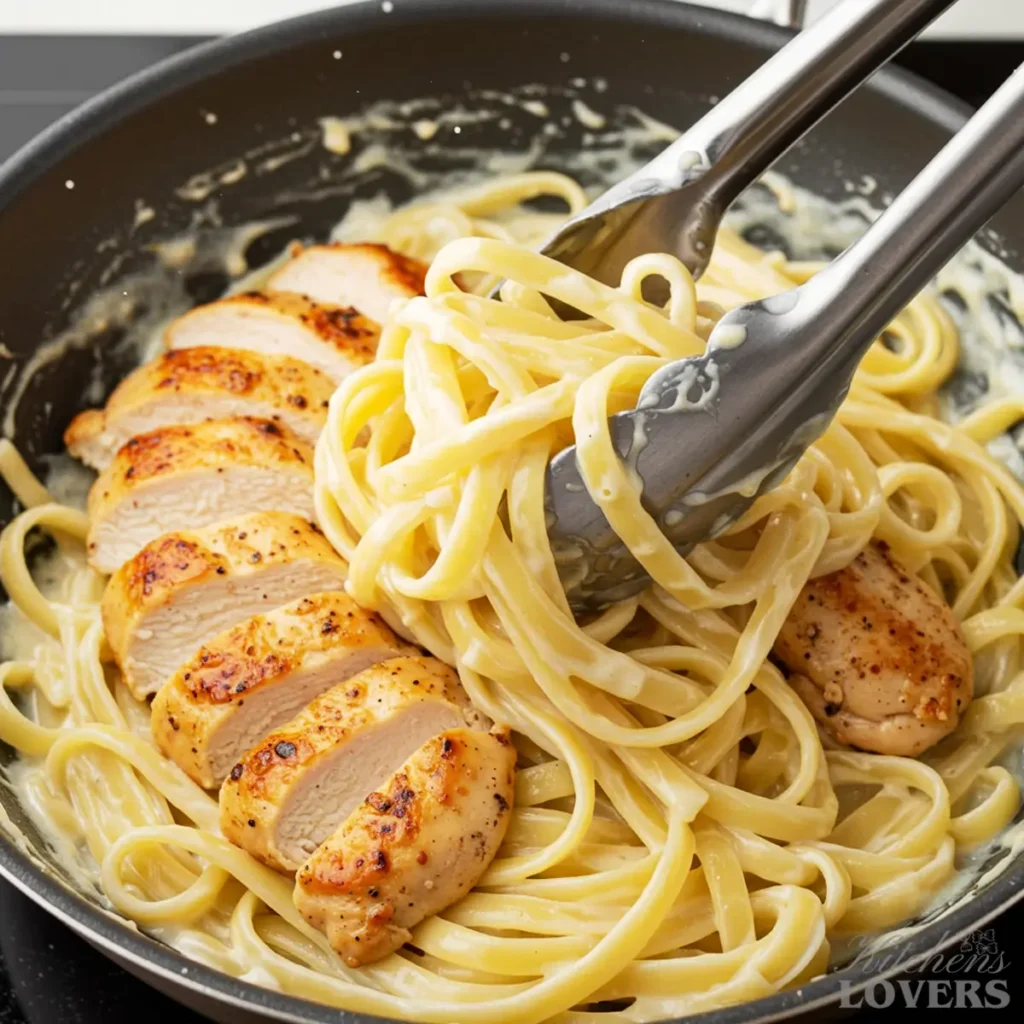
- Combine and Coat: Add the cooked fettuccine and the sliced chicken directly into the skillet with your beautiful Alfredo sauce. Use tongs to toss everything together gently, ensuring every single strand of pasta and piece of chicken is coated in creamy luxury.
- Adjust Consistency (If Needed): If the sauce seems a little too thick, this is where your reserved pasta water comes in. Add a tablespoon or two at a time to thin it out to your desired consistency.
- Serve Immediately: Pile the chicken alfredo high in warm bowls. Garnish with a little extra Parmesan cheese and some fresh parsley if you like. Serve hot and enjoy the silence as everyone takes their first, perfect bite.
Pro Variations to Make It Your Own
Once you’ve mastered the core recipe, it becomes a fantastic canvas for creativity. I’ve tested dozens of twists over the years, and these are a few of my absolute favorite, foolproof variations.
Add Some Green: Broccoli or Spinach
Bringing a fresh vegetable into the mix is a great way to round out the meal. My two top choices are broccoli and spinach because they don’t overpower the sauce.
- For Perfect Broccoli Florets: Chop one head of broccoli into small, bite-sized florets. The secret is to steam or blanch them separately until they are bright green and just tender-crisp. Don’t boil them to mush! You can do this while the pasta cooks. Then, simply fold the cooked florets into the final dish right when you combine the pasta and chicken with the sauce.
- For Easy Wilted Spinach: This one couldn’t be simpler. After your sauce is finished and perfectly smooth, add a few large handfuls of fresh baby spinach directly into the pan. Stir it into the hot sauce for a minute or two. The residual heat will wilt it down perfectly without making it watery.
Turn Up the Heat: Blackened Cajun Alfredo
When you want to trade a bit of that Italian romance for a bold, bayou-inspired kick, this is the way to go. The creamy sauce is a perfect balance for the assertive spice.
- Blacken the Chicken: Instead of just salt and pepper, generously coat your chicken breasts on all sides with a good Cajun or Creole seasoning blend before you sear them. A quick pro tip: Check the ingredients on your seasoning blend. If salt is one of the first two ingredients, you should significantly reduce or even eliminate the other salt you add to the chicken and the final sauce. You can always taste and add more salt at the end! For an even more authentic flavor, sear them in a screaming-hot cast-iron skillet to get that signature dark, “blackened” crust.
- Spice the Sauce (Optional): For a deeper flavor, you can add a half-teaspoon of your Cajun seasoning into the roux along with the flour. It will infuse the entire sauce with a gentle, smoky heat. If you really want to go all out, toss some sliced, pan-fried andouille sausage in with the chicken.
The Ultimate Indulgence: Black Truffle Alfredo
Ready for a truly show-stopping, five-star restaurant experience? Adding black truffle is pure magic. It transforms this dish into something incredibly luxurious and complex. But be careful—a little goes a long way, and you must add it correctly.
- Get the Right Stuff: You don’t need fresh, shaved truffles (though that would be amazing!). A high-quality black truffle oil or black truffle salt will do the trick beautifully. When you shop, look for an oil whose ingredient list includes actual bits of black truffle, not just “truffle flavor” or “truffle aroma.” The difference in true flavor is astounding.
- Timing is Everything: Never cook the truffle oil! Heat destroys its delicate, volatile aromas. After your Alfredo sauce is completely finished and taken off the heat, stir in one to two teaspoons of the oil (or a half-teaspoon of the salt).
- Perfect Pairing: Want to elevate it even more? Sauté 8 ounces of sliced cremini or shiitake mushrooms in the pan after you remove the chicken and add them to the final dish. The earthy mushrooms are a perfect match for the truffle.
Storing, Freezing, and Perfectly Reheating Your Alfredo
Let’s be honest: one of the best things about a big pasta dinner is the leftovers. But so many people are disappointed when their once-creamy Alfredo turns into a clumpy, oily mess the next day. Even worse, most will tell you that freezing a cream sauce is impossible.
I’m here to tell you they’re wrong. Because we built our sauce with a stable flour-and-butter base (our roux), it behaves beautifully when stored and reheated correctly. Just follow these steps.
In the Refrigerator
Properly stored in an airtight container, your Chicken Alfredo will be delicious for up to 4 days. The sauce will thicken considerably when it’s cold, but don’t worry—that’s completely normal, and we will handle it in the reheating step.
How to Freeze Chicken Alfredo (Yes, Really!)
This is the ultimate meal-prep secret. The roux in our sauce acts as a powerful stabilizer, preventing the dairy from completely breaking apart during the freezing and thawing process, which is exactly what happens with simpler, roux-less sauces.
- Cool Completely: This is the most important step. You must let the Alfredo cool down to room temperature before freezing it. Putting hot food in the freezer creates ice crystals, which will ruin the texture, and it also puts your freezer into overdrive.
- Portion It Out: Divide the cooled Alfredo into individual or family-sized portions in freezer-safe airtight containers or zip-top bags. If using bags, squeeze out as much air as possible before sealing.
- Label and Freeze: Label your containers with the date. It will maintain its best quality for up to 3 months.
The Secret to Reheating for Creamy-Again Results
The golden rule for reheating Alfredo is low heat and a little patience. High heat is the enemy; it will shock the sauce and cause it to separate and turn oily. Our goal is to gently coax it back to its original creamy glory.
The Best Method: Stovetop
This is my non-negotiable method for perfect results every time.
- Thaw First: For best results, thaw your frozen Alfredo in the refrigerator overnight. Forgot to thaw? Don’t panic. You can still use this method, but it will require a bit more patience. Add the frozen block to the saucepan with two or three tablespoons of milk, cover the pan, and keep the heat on its absolute lowest setting. It will take longer, but it will get there.
- Low and Slow: Scrape the leftovers into a small saucepan and place it over low heat. The sauce will look very thick and unappealing. This is expected.
- Add a Splash of Liquid: Add a splash of whole milk or a touch of cream to the pan. I recommend sticking with the full-fat dairy we used in the original recipe to ensure the richest flavor and best consistency.
- Stir Gently, but Constantly: As the Alfredo warms up, stir it gently. You’ll witness the magic firsthand as the sauce loosens up and transforms back into a smooth, creamy, perfectly emulsified state. This should only take a few minutes. Never let it come to a boil!
The “In-a-Pinch” Method: Microwave
I recommend the stovetop, but you can use the microwave if you’re short on time. You just need to be careful.
- Place leftovers in a microwave-safe bowl. Add your splash of milk or cream.
- Microwave on 50% power, not full power. Heat it in short 60-second intervals, stopping to stir thoroughly after each one.
- Stop as soon as it’s warmed through. This method is riskier, as it’s much easier to overheat and break the sauce.
What to Serve With Your Chicken Alfredo
A dish this decadent and creamy doesn’t need another heavy sidekick. It is the star of the show, and our philosophy here at KitchensLovers for all our Crave-worthy chicken pasta dishes is to complement, not compete. We are looking for sides that provide a bright, fresh contrast to cut through the richness and cleanse the palate between each glorious bite. Skip the heavy garlic bread and instead try one of these elegant, chef-approved pairings.
1. Simple Arugula Salad with Lemon Vinaigrette
- The Flavor Logic: This is my number one choice for a reason. The sharp, peppery bite of fresh arugula and the high-acidity dressing act like a reset button for your taste buds. While the Alfredo is rich, creamy, and savory, this salad is bright, acidic, and fresh. It’s a perfect, sophisticated contrast that keeps the entire meal from feeling too heavy. Simply toss baby arugula with extra virgin olive oil, fresh lemon juice, salt, and pepper. For a beautiful finish, add some paper-thin shavings of that extra Parmesan. This kind of bright, simple salad is also the perfect partner for other famously rich Italian-American dishes, like my authentic Chicken Carbonara recipe.
2. Flash-Roasted Broccolini with Chili Flakes
- The Flavor Logic: Instead of simple steamed vegetables, roasting brings out a deep, nutty sweetness and a pleasant, charred bitterness that stands up beautifully to the cream sauce. Broccolini is ideal because its long, tender-crisp stalks offer a wonderful textural difference from the soft pasta. Toss it with olive oil, salt, and a pinch of red pepper flakes and roast at a high temperature (400°F / 200°C) for just 10-15 minutes until the edges are crispy. The subtle heat from the chili provides another layer of complexity that highlights the flavor of the chicken.
3. Simple Roasted Cherry Tomatoes
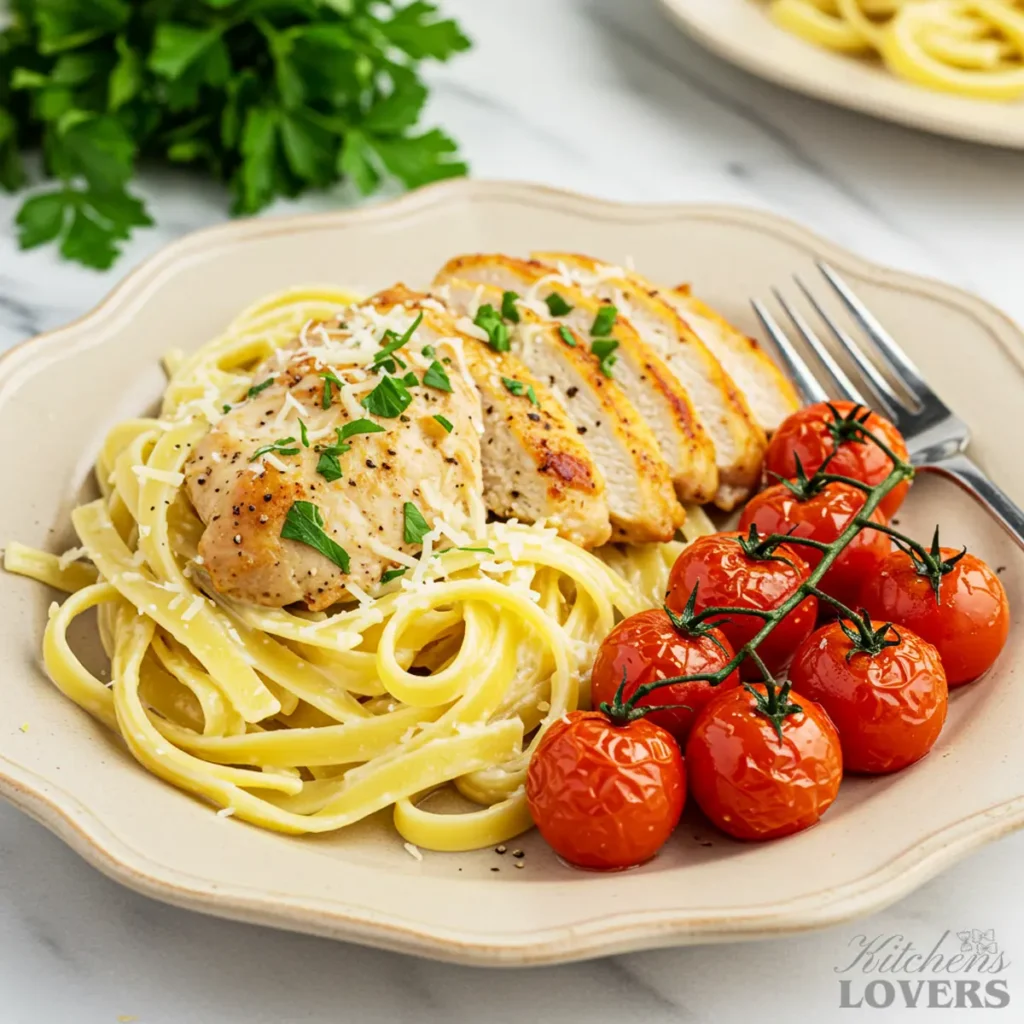
- The Flavor Logic: This is elegance in its simplest form. Roasting cherry tomatoes at high heat concentrates their natural sugars and deepens their flavor, turning them into sweet, tangy jewels that burst in your mouth. This intense pop of acidity is the absolute perfect counterpoint to the rich, creamy Alfredo sauce, cutting through the decadence and keeping your palate refreshed. For a beautiful presentation, you can even roast them right on the vine. Just toss with a little olive oil and salt and roast at 400°F (200°C) until blistered and tender.
Frequently Asked Questions About Chicken Alfredo
I get a lot of questions about making pasta from scratch, and Alfredo is always a hot topic. Here are the clear, no-nonsense answers to the most common ones.
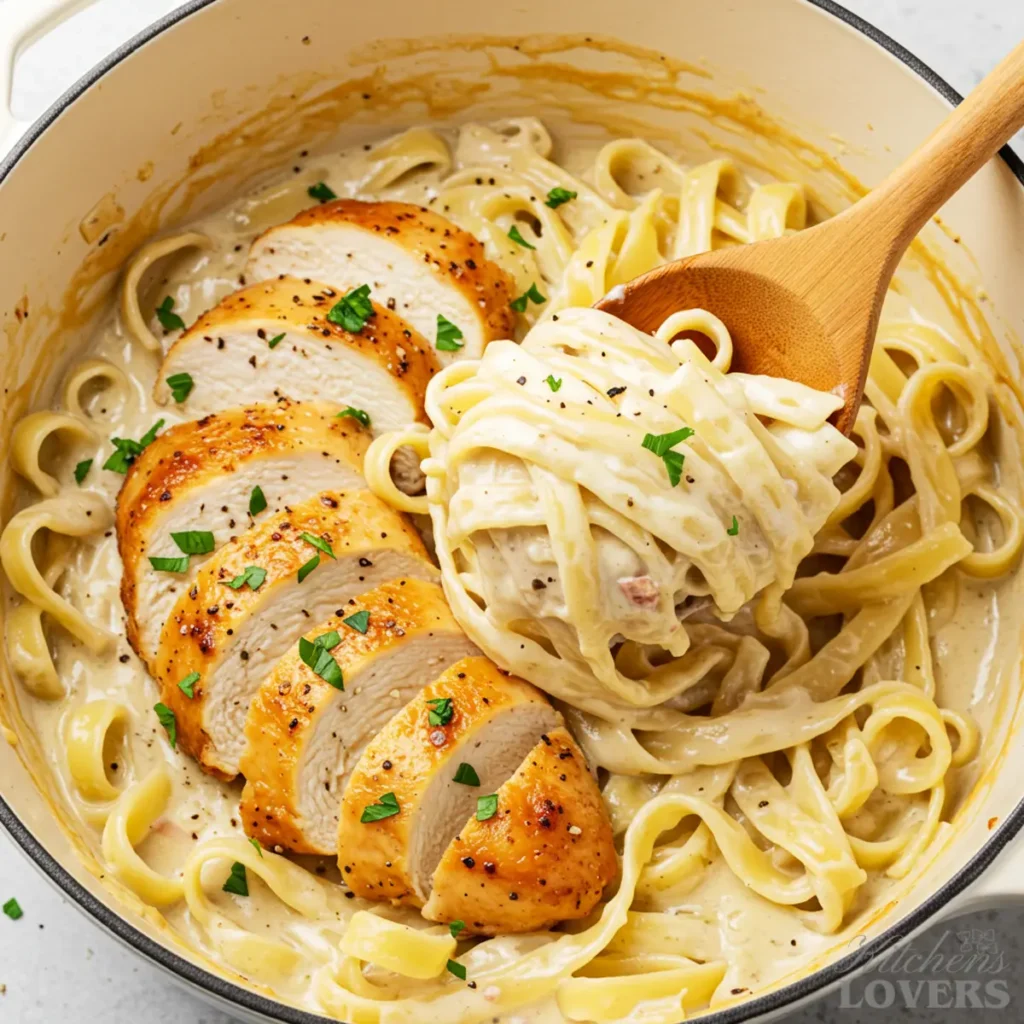
Pasta & Cream
Traditionally, the perfect partner is Fettuccine. Its wide, flat, and porous surface gives the rich, creamy sauce plenty of area to cling to, which is why “Fettuccine Alfredo” is a classic pairing. However, any long, flat pasta like pappardelle or linguine will also work beautifully. In a pinch, a sturdy tube-shaped pasta like penne or rigatoni can work, as their ridges will help trap the sauce.
You can, but I don’t recommend it for this recipe if you want that truly luxurious, restaurant-quality result. Heavy cream has a high-fat content (around 36%), which is what makes it so resistant to curdling and gives Alfredo its signature velvety richness. If you were to use only milk (which has a much lower fat content), you would end up with a significantly thinner, less flavorful sauce that is at a much higher risk of breaking or turning grainy when you add the cheese. The combination of milk and cream in our recipe provides the perfect balance of richness and consistency.
Flavor & Tradition
This recipe is designed to build deep flavor from the start, but if you want to dial it up, here are my top tips. First, don’t leave behind the fond—the browned bits stuck to the bottom of the pan after you sear the chicken. That’s a goldmine of flavor that becomes part of our sauce. Second, be sure to gently “toast” your garlic and the flour-butter roux until you get that nutty aroma; this adds incredible depth. Finally, a tiny pinch of fresh nutmeg is a classic professional trick that enhances all the other savory flavors. For more adventurous twists, check out our Pro Variations section.
That’s an excellent question, and the answer is no—but for a very important reason. The truly “traditional” Alfredo created in Rome by Alfredo di Lelio in the early 20th century contained only three ingredients: fresh pasta, butter, and Parmigiano-Reggiano, emulsified with hot, starchy pasta water. The creamy, dairy-rich version we know and love is an American adaptation. My recipe takes that beloved American version and makes it a thousand times better and more reliable by using a classic French Béchamel technique. This builds in a stable foundation (the roux) that guarantees the ultra-creamy, silky, and “unbreakable” sauce that most people are actually dreaming of when they say “Chicken Alfredo from scratch.” It’s the best of all worlds: traditional technique for a perfect modern result.
Share Your Success!
I truly believe this is the best, most foolproof chicken alfredo recipe out there, and I put all my years of kitchen experience into making sure it would work perfectly for you. Now, I’d love to know how your chicken alfredo from scratch turned out! Did you have that “aha!” moment when you saw how silky the sauce was? Did you try one of the variations? Please leave a star rating and a comment below to let me know!
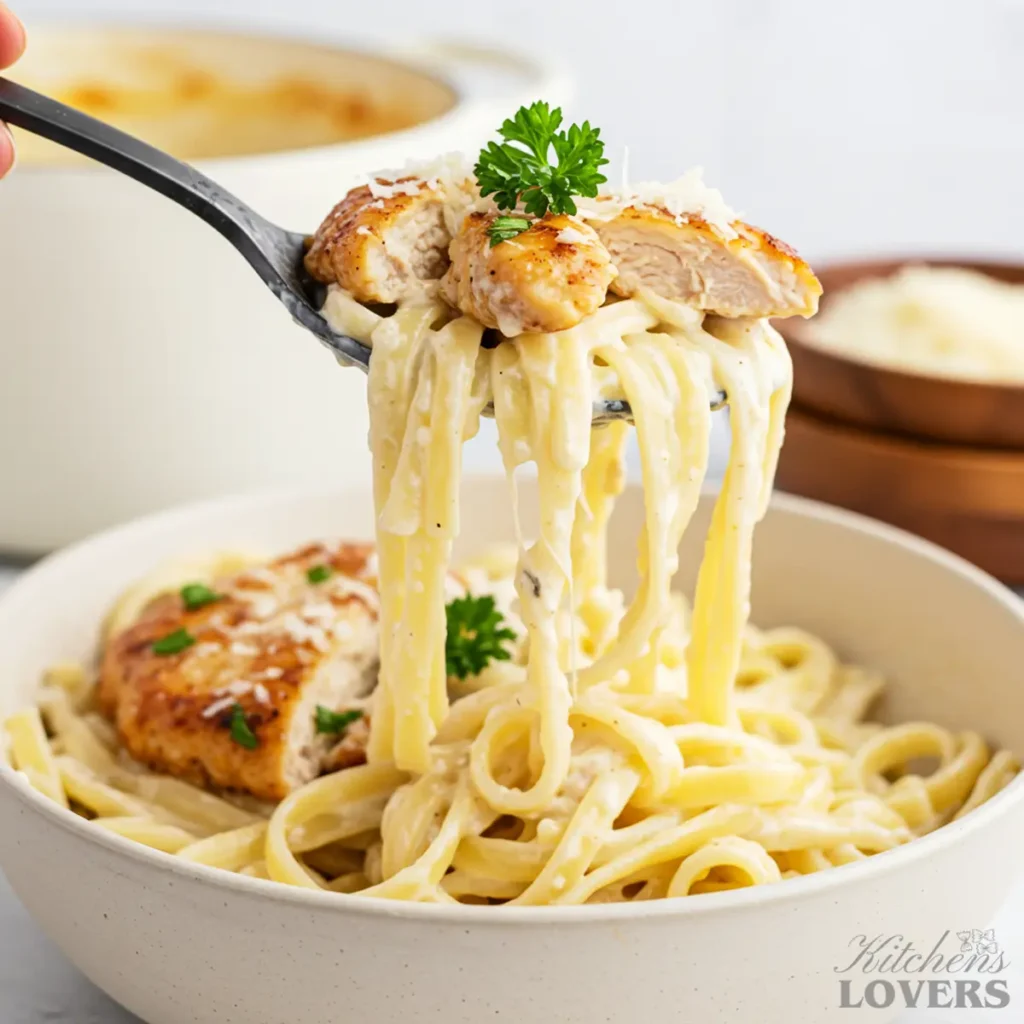
If you’re like me and believe that a delicious, creamy chicken pasta can solve just about anything, then I know you’ll fall in love with my Creamy Tuscan Chicken Pasta. It has that same comforting, satisfying feel but with a sun-dried tomato and spinach twist that is absolutely irresistible.
Want more foolproof recipes delivered right to your inbox? Join the KitchensLovers family! Sign up for our newsletter to get my latest and greatest creations, pro tips, and exclusive content that will make you a more confident cook.
About the Author
Kate Thompson created KitchensLovers.com to simplify dinner for real-life families. She develops easy, flavor-packed chicken pasta recipes tested dozens of times to guarantee results. Her motto: ‘Easy Pasta, Every Time.’
The Science of a Silky Sauce (Why This Recipe Can’t Fail)
Have you ever wondered why this foolproof method works so flawlessly when just dumping cheese into cream can be such a gamble? The answer isn’t magic; it’s simple, classic kitchen science that pros have relied on for centuries. This is the bedrock of our unbreakable sauce.
Let’s geek out for just a minute. It all comes down to controlling how starch behaves in liquid.
The Problem: Clumps
If you were to just dump raw flour into hot milk, the starch granules on the outside of the flour clumps would instantly gelatinize and form a sticky barrier, leaving a pocket of dry, lumpy flour on the inside. No amount of whisking can fix that pasty mess.
The Solution: The Roux
This is where the genius of the roux comes in—the simple act of cooking flour and fat (in our case, butter) together first. When you whisk the flour into the hot butter, the fat coats and separates every single tiny starch granule. Think of it as putting a waterproof, slippery jacket on each one. They can’t stick together anymore. Cooking it for that extra 60-90 seconds also toasts the flour, deepening the flavor from a raw paste to a nutty, complex base.
The Result: A Flawless Béchamel
Now, when you slowly pour your milk into this roux, the separated, fat-coated flour particles can swell up individually and dissolve evenly into the liquid, thickening it into a perfectly smooth, stable emulsion. What you have just created is a classic Béchamel sauce—one of the five ‘mother sauces’ of French cuisine—which serves as the backbone for countless other dishes.
This stable, thickened Béchamel is the ultimate insurance policy for your Alfredo. It creates a strong, reliable base that can handle the addition of the Parmesan cheese without panicking. The cheese isn’t being thrown into volatile, thin cream; it’s being gently stirred into a sturdy, established sauce that welcomes it, allowing it to melt into a silky, cohesive dream.
That’s the whole secret. It’s not a shortcut; it’s a foundation. And it’s why your chicken alfredo from scratch will never be grainy, oily, or broken again.
This recipe was last tested and updated in August 2025 to ensure perfect results.
Chicken Alfredo from Scratch
Equipment
- Large, Heavy-Bottomed Pan or Dutch Oven
- Sturdy Whisk
- Large Pot (for pasta)
- Box Grater or Microplane
Ingredients
For the Chicken & Pasta
- – 1.5 lbs boneless skinless chicken breast, pounded to an even ½-inch thickness
- – 1 lb fettuccine pasta
- – 1 tbsp olive oil
- – 1 tbsp unsalted butter for searing the chicken
- – Salt and fresh black pepper to taste
For the Foolproof Alfredo Sauce
- – 4 tbsp unsalted butter
- – 3 cloves garlic finely minced
- – 4 tbsp all-purpose flour
- – 1 cup whole milk
- – 1 cup heavy cream
- – 1.5 cups Parmesan cheese freshly grated from a block, not pre-shredded
- – 1 pinch fresh nutmeg
Instructions
- Start the Pasta Water & Prep: Get a large pot of water on the boil and salt it generously. While it heats, pound chicken to ½-inch thickness, pat dry, and season both sides with salt and pepper.
- Cook the Fettuccine: Add fettuccine to boiling water and cook to al dente according to package directions. Important: Reserve about 1 cup of the starchy pasta water before draining.
- Sear the Chicken: In a large, heavy-bottomed skillet over medium-high heat, add 1 tbsp of butter and 1 tbsp of olive oil. Sear the chicken for 4-6 minutes per side until golden-brown and cooked through. Transfer to a cutting board to rest for 5 minutes, then slice. Do not wipe out the pan.
- Make the Roux: Reduce pan heat to medium. Add 4 tbsp butter. Once melted, sauté minced garlic for 30-60 seconds until fragrant. Sprinkle flour over top and whisk constantly for 90 seconds to cook out the raw flour taste and form a sandy paste.
- Build the Cream Sauce: While whisking, slowly stream in the whole milk until smooth. Then whisk in the heavy cream and pinch of nutmeg. Bring to a gentle simmer and let it thicken for 2-3 minutes.
- Finish with Cheese: Turn heat to low. Add the freshly grated Parmesan in batches, stirring gently until each addition is fully melted and the sauce is velvety smooth. Taste and season with additional salt and pepper if needed.
- Bring It All Together: Add the cooked fettuccine and sliced chicken directly into the sauce. Use tongs to toss until everything is coated. If the sauce is too thick, thin it with a splash of the reserved pasta water. Serve immediately.
Notes
- Recipe Rescue for Grainy Sauce: Immediately remove the pan from heat, add a splash of COLD cream, and whisk vigorously from the center out until the sauce comes back together.
- The Golden Rule: NEVER use pre-shredded, bagged Parmesan. It contains anti-caking agents that prevent smooth melting and cause a grainy texture. Grating your own is the single most important step for a velvety sauce.
